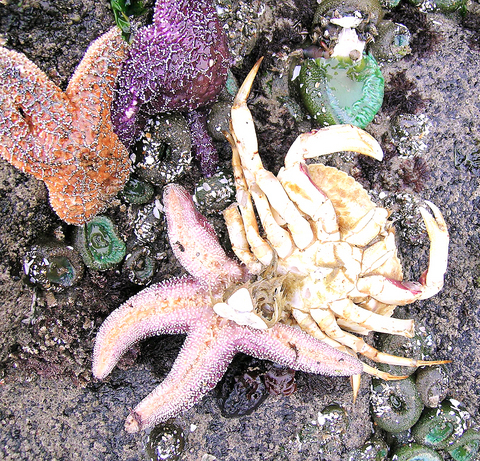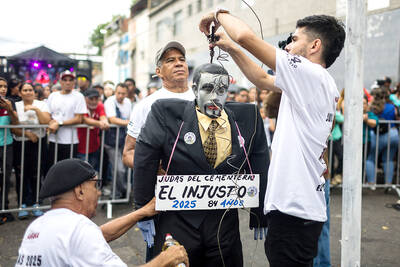The oxygen-starved "dead zone" along the US Pacific Coast that is causing massive crab and fish die-offs is worse than initially thought, scientists said.
Weather, not pollution, appears to be the culprit, scientists said, and no relief is in sight. However, some said there is no immediate sign of long-term damage to the crab fishery in the dead zone, a 115km stretch of water along the Continental Shelf between Florence and Lincoln City.
Oregon State University (OSU) scientists looking for weather changes that could reverse the situation aren't finding them. They say levels of dissolved oxygen critical to marine life are the lowest since the first dead zone was identified in 2002. It has returned every year.

PHOTO: AP
Strong upwelling winds pushed a low-oxygen pool of deep water toward shore, suffocating marine life, said Jane Lubchenco, a professor of marine biology at OSU.
She said wind changes could help push that water farther out, but current forecasts predict the opposite.
After a recent trip to the dead zone and an inspection via camera on a remote-controlled submarine, she said, "We saw a crab graveyard and no fish the entire day."
"Thousands and thousands of dead crab and molts were littering the ocean floor. Many sea stars were dead, and the fish have either left the area or have died and been washed away," she said.
The effect on the commercial fishery isn't yet known, said Hal Weeks, a marine ecologist with the Oregon Department of Fish and Wildlife. He said the last two years were record-breaking for the Dungeness crab despite dead zones.
"In that fishery there has been no apparent effect. That doesn't mean there won't be," he said.
Weeks said crab populations fluctuate wildly for reasons not well understood. Whether any harvest decline is a result of normal fluctuation or the effects of the dead zone is hard to say, he said.
He said some reports indicate the loss of fin fish may be due to their movement to areas with more oxygen rather than to mortality.
Al Pazar, chairman of the Oregon Dungeness Crab Commission and a crab fisherman out of Newport, said this season is shaping up to be the second-best ever, around 12.6 million kg, but that most crabs are caught in the six or eight weeks following the season's winter opening, well ahead of the appearance of the dead zones.
Few boats are fishing now, he said, and the season closes at midnight Monday. But he said the affected area is a major crab producer, "right in the thick of it."
The 2002 dead zone was the worst until this year's, he said. After 2002, he returned to the area when the season reopened and had good results.
"They [the creatures] do move back in eventually," he said.
Oregon State scientists working with the Oregon Department of Fish and Wildlife used a remote-control device Aug. 8 to check biological impact and continue oxygen sampling.
Dissolved oxygen readings off of Cape Perpetua north of Florence are between 3 percent and 10 percent of levels needed for survival and near zero in some areas.

POLITICAL PRISONERS VS DEPORTEES: Venezuela’s prosecutor’s office slammed the call by El Salvador’s leader, accusing him of crimes against humanity Salvadoran President Nayib Bukele on Sunday proposed carrying out a prisoner swap with Venezuela, suggesting he would exchange Venezuelan deportees from the US his government has kept imprisoned for what he called “political prisoners” in Venezuela. In a post on X, directed at Venezuelan President Nicolas Maduro, Bukele listed off a number of family members of high-level opposition figures in Venezuela, journalists and activists detained during the South American government’s electoral crackdown last year. “The only reason they are imprisoned is for having opposed you and your electoral fraud,” he wrote to Maduro. “However, I want to propose a humanitarian agreement that

ECONOMIC WORRIES: The ruling PAP faces voters amid concerns that the city-state faces the possibility of a recession and job losses amid Washington’s tariffs Singapore yesterday finalized contestants for its general election on Saturday next week, with the ruling People’s Action Party (PAP) fielding 32 new candidates in the biggest refresh of the party that has ruled the city-state since independence in 1965. The move follows a pledge by Singaporean Prime Minister Lawrence Wong (黃循財), who took office last year and assumed the PAP leadership, to “bring in new blood, new ideas and new energy” to steer the country of 6 million people. His latest shake-up beats that of predecessors Lee Hsien Loong (李顯龍) and Goh Chok Tong (吳作棟), who replaced 24 and 11 politicians respectively

Young women standing idly around a park in Tokyo’s west suggest that a giant statue of Godzilla is not the only attraction for a record number of foreign tourists. Their faces lit by the cold glow of their phones, the women lining Okubo Park are evidence that sex tourism has developed as a dark flipside to the bustling Kabukicho nightlife district. Increasing numbers of foreign men are flocking to the area after seeing videos on social media. One of the women said that the area near Kabukicho, where Godzilla rumbles and belches smoke atop a cinema, has become a “real

‘POINT OF NO RETURN’: The Caribbean nation needs increased international funding and support for a multinational force to help police tackle expanding gang violence The top UN official in Haiti on Monday sounded an alarm to the UN Security Council that escalating gang violence is liable to lead the Caribbean nation to “a point of no return.” Special Representative of the UN Secretary-General for Haiti Maria Isabel Salvador said that “Haiti could face total chaos” without increased funding and support for the operation of the Kenya-led multinational force helping Haiti’s police to tackle the gangs’ expanding violence into areas beyond the capital, Port-Au-Prince. Most recently, gangs seized the city of Mirebalais in central Haiti, and during the attack more than 500 prisoners were freed, she said.